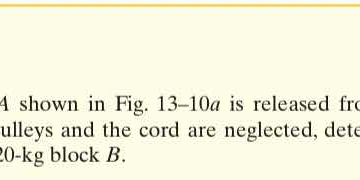A system with a 20-kg block B is released from pulleys and the cord are neglected. Determine the motion or force related to the block.

Understand the Problem
The question is asking to determine the motion or force related to a 20-kg block B when it is released from a setup with pulleys and a cord, suggesting a need for applying physics concepts such as dynamics and possibly employing Newton's laws.
Answer
The block accelerates downwards at $9.81 \, \text{m/s}^2$.
Answer for screen readers
The block accelerates downwards at $9.81 , \text{m/s}^2$.
Steps to Solve
-
Identify the Forces Acting on the Block The block B has a weight force acting downwards due to gravity. This force can be calculated using the equation: $$ F_g = m \cdot g $$ where $m = 20 , \text{kg}$ is the mass of the block and $g = 9.81 , \text{m/s}^2$ is the acceleration due to gravity.
-
Calculate the Weight of the Block Substituting the values into the weight formula: $$ F_g = 20 , \text{kg} \cdot 9.81 , \text{m/s}^2 = 196.2 , \text{N} $$ This is the force of gravity acting on the block.
-
Consider Motion Upon Release When the block is released, it will accelerate downwards due to the gravitational force since there are no other forces acting on it (the problem states the cord and pulleys are neglected). According to Newton's second law: $$ F_{net} = m \cdot a $$ Here, the net force $F_{net}$ is simply the weight of the block.
-
Calculate the Acceleration of the Block Since $F_{net} = F_g$, we can find the acceleration: $$ a = \frac{F_{net}}{m} = \frac{F_g}{m} = \frac{196.2 , \text{N}}{20 , \text{kg}} = 9.81 , \text{m/s}^2 $$ Thus, the block will accelerate downwards at $9.81 , \text{m/s}^2$.
-
State the Conclusion Therefore, when the block is released, it will accelerate downwards with an acceleration of $9.81 , \text{m/s}^2$.
The block accelerates downwards at $9.81 , \text{m/s}^2$.
More Information
This motion corresponds to the acceleration due to gravity, which is the same for all objects in free fall near the surface of the Earth, regardless of their mass.
Tips
- Forgetting to calculate the gravitational force before determining acceleration.
- Incorrectly assuming friction or other forces are at play when they are not present in the problem.
AI-generated content may contain errors. Please verify critical information